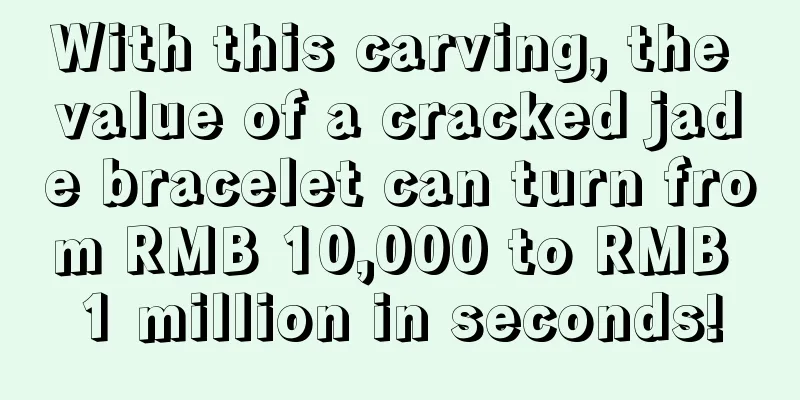Identification of B-grade Jadeite

|
Ultraviolet fluorescence reaction: Natural A-grade jadeite usually has no fluorescence reaction under ultraviolet fluorescence. Grade B jadeite has a stronger blue-white fluorescent reaction. The influencing factor is the type of filling resin. In addition, some wax immersion also has weak to moderate blue-white fluorescence reaction. Therefore, the fluorescence reaction also has a reference value of 70% to 80%. Frictional heat method: Someone once discovered that by rubbing B-grade jadeite to generate heat, it can absorb small pieces of paper. This is the principle of electrostatic attraction caused by frictional heat generated by resin. It is very consistent with scientific principles and can be operated anywhere. The use of this method depends on the weather humidity, the heat of friction, and the size of the paper scraps. (I always feel that it is a bit like what is said in novels that requires the right time, right place and right people.) Rub the jade quickly on the woolen clothes for about 30 seconds, until your hands feel hot. If it can absorb paper scraps, it is a B-grade product. If it cannot, it may not be a A-grade product either. We can only say that there is a probability. In fact, I still think that this method can only be used as an auxiliary means. Infrared spectroscopy identification: Infrared spectroscopy is currently the most scientific, accurate, sensitive and rapid detection method. It is a powerful tool for detecting whether B-grade jadeite contains epoxy resin. Its appearance saved the sluggish jade market and made people regain confidence in jade. It is mainly used to identify the chemical composition of substances and determine whether the substance contains water through ion vibration. It is most sensitive for detecting organic matter and is often used in textiles, chemical industry, materials science and other fields. Raman spectroscopy identification: Raman spectroscopy mainly uses a single color light, that is, radium light, to excite the sample. The reflected Raman scattering signal passes through the Raman spectrometer and is then received by the CCD (charge coupled device). Finally, it is processed by a computer to obtain a Raman spectrum. Raman spectrometers are mostly used to identify mineral types, and can also be used to identify B-grade jadeite. The advantages of Raman spectroscopy are that it is not affected by the size, thickness and transparency of the object to be identified, does not damage the object to be identified, does not require the ring to be removed, and is fast and accurate. The disadvantage is that it is easy to produce a strong fluorescence reaction under the laser source, which will affect the detection results. It is easy to misjudge those with insufficient fat filling or when the detection point does not contain resin. So it is best to test at multiple points during testing. After studying B-grade jadeite for the past two days, I think everyone should have a better idea of it. Some people may ask, can slightly processed jade be considered B-grade jade? In fact, as long as it is filled with resin, it can be considered B-grade jade, because it may age. It's just a matter of time. The price of A-grade jadeite ranges from one or two million to tens of millions. There is really no need to buy B-grade jadeite because, firstly, it has no room for appreciation in value, and secondly, its luster will become worse and worse after being worn for a long time. Therefore, you must open your eyes and look carefully when purchasing, and don't confuse A and B. fcgc66 fcpf18 |
<<: Investing in jadeite correctly, investing in jadeite is a good choice!
>>: How to identify high-quality imitation jadeite through photos?
Recommend
The eight-armed Guanyin of jadeite with floating flowers, the figure depicts the skill step by step
Rough Stone By chance, I found a piece of ice-typ...
What does jade quality mean? When it comes to appearance, should we look at the type or the color first?
In fact, the term "appearance" is not d...
What are the precautions for women to wear Pixiu? Are there any things they need to pay attention to?
Jewelry is the most loyal companion of female fri...
How to clean jade after wearing it for a long time, these tips are very useful!
Jade lovers who often wear jade jewelry know that...
Are emerald eyes the most precious? What's going on? Jade has eyes.
As the saying goes, eyes are the windows to the s...
Do you know the two forms of jadeite’s “jade nature”?
We all know that in the process of purchasing jad...
Jade Appreciation | Full of holes and yet breathtakingly beautiful
incomplete, It is a unique aesthetic. It is also ...
How to identify the authenticity of jadeite? It turns out that these are the signs of fake jade
How to identify the authenticity of jade is a que...
What is the green color of jadeite? It really increased my knowledge!
When we buy jade jewelry, we often hear merchants...
What misunderstandings should we avoid when choosing jadeite?
Nowadays, people's living standards are getti...
You can easily tell whether jade is real or fake with just a bowl of water. Have you learned it?
Jade has been praised as the magic weapon of the ...
Jade actually has such a beautiful mythological story
Chinese culture is extensive and profound, with a...
Let you know the identification skills of jadeite rough stone
With the rapid development of the market for high...
Is there any new carving technology? So surprising!
The difficulty in finding good materials and the ...
"Jadeite" is the king of jade! Analyze its investment prospects?
Industry insiders said that individual investors’...









